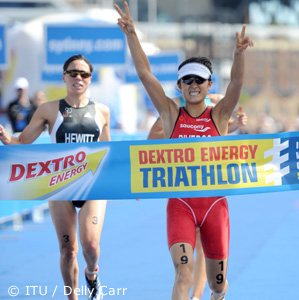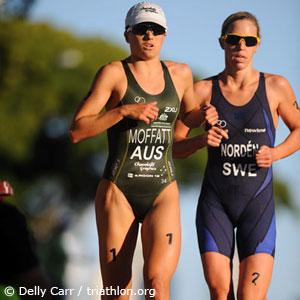Introducing Barbara Riveros Diaz
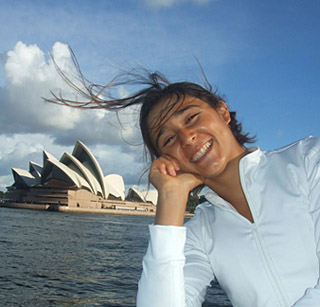
The 2010 Dextro Energy ITU World Championship Series opened with a shocker as little known Chilean triathlete Barbara Riveros Diaz took down last year’s top three triathletes in an exciting dash for the finish at Sydney. The 4-foot 11–inch Riveros Diaz, perhaps the shortest competitor on the ITU circuit, stood tall at the end after outrunning 2009 ITU world champion Emma Moffatt, who finished 3rd; World Championship Series bronze medalist Andrea Hewitt, who finished 2nd; and ITU WCS runner-up Lisa Norden, who finished 5th, by prevailing by one second in a tense, last lap duel for the Sydney crown.
Like Sweden’s Norden, who trains with Riveros Diaz in Australian coach Darren Smith’s talented squad, the 22-year-old Chilean is a product of the International Triathlon Union’s innovative sport development program for promising young triathletes who come from countries without a well-developed triathlon federation. The program’s innovative leader, Libby Burrell, put it best when she said of the tiny Chilean competitor: “She is small in stature but big in heart… She is a tenacious young athlete that fully understands what it takes to be a champion.” That involved moving her training as a teenager from her home in Chile to Wollongong, Australia and Vittorio Spain with Jamie Turner and then Australia’s Capital, Canberra with Darren Smith and devoting herself to the world circuit.
Riveros Diaz’s previous highlights were a 5th place at the 2008 ITU Under 23 World Championship and a 5th place at the Hamburg round of the Dextro Energy World Championship Series last summer. Because she was the highest ranked Pan American athlete, Riveros Diaz earned an Olympic slot at age 21 for the 2008 Beijing Games where she finished 25th of 50 starters.
Riveros Diaz fought hard under Australian coach Jamie Turner last year to make an impact on the Dextro Energy World Championship Series circuit, but was fighting a series of small injuries to a calf and hip flexor. Many times she would fight off the usual hits in the swim and end up missing the front pack on the bike, making the best of her chances with the chase packs with a 16th place at Washington DC and an 11th at the Hy-Vee World Cup.
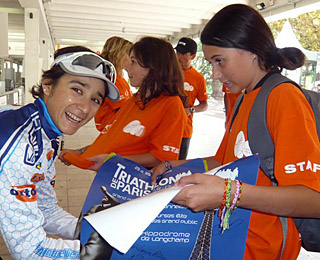
When Jamie Turner was hired at the end of last season to coach for his national federation, he was no longer allowed to work with Riveros Diaz. Seeking a new coach, she came to Darren Smith, who had great success last year coaching world number 2 Lisa Norden, top contender Daniela Ryf (now with a new coach) and whom this year also works with rising American Sarah Groff and Czech star Vendula Frintova.
“I’ll never forget what she told me when we first talked,” said Smith. “She said 'Darren, I don't care how hard you push me. Tell me what you want me to do. I am not afraid of blood.' She is a bit nuts in a South American sort of way. She is passionate, driven and fights hard for things. I think it is fair to say we all love her to bits.”
A week after her big victory, Riveros Diaz and her coach spoke separately with Slowtwitch by telephone from Australia’s Gold Coast. Their comments were combined later into this Q&A.
Slowtwitch: How did you feel going into the Sydney race?
Barbara Riveros Diaz: The week before I was really tired because I had raced at the Pan American Games in Colombia and had been training there afterward. So I was jet lagged when I came to Australia a few days before the race. I thought: OK. I will do my best and see what I can do.
ST: Were you surprised by your performance – being competitive with and beating the top three triathletes in the world?
Barbara: My dream was once to be in the Olympics and I did it. Then it was to make the top 10 in a World Cup race and I did it last year at Hamburg. And then my dream was to one day have a World Cup win. I have been doing these races for a long time and I knew this year I was better than the year before.
ST: Last year you were usually a minute and a half behind the winners on the run in World Championship Series races. What are your best 5k and 10k run times?
Barbara: I never train to run a 10k alone. But my best 5k time was 16:43 and in triathlon on an accurate course I run 10k more or less in 35 minutes flat.
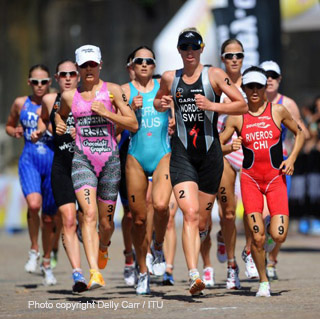
ST: How did your race in Sydney start? I see you were about 40th out of the water – but just 32 seconds behind the first swimmer.
Barbara: Once the bike started, I was in the second group. We worked pretty hard and made it up to the big lead group.
ST: Did you at some point try to make a break on the bike?
Barbara: I like to pull the whole 40k and a few of us were working pretty hard and tried to break away. But I think they slowed down. I don’t know why but maybe they wanted to save energy for the run. I thought if we can break away good. If not, it is OK, wait for the run.
ST: Still near the end of the ride, when 40 women rode together I saw you worked to get to the front just before the transition.
Barbara: It is really important to have a good transition to get out on the run in front before we get to the first hill. So I rode hard coming into transition. It is definitely important to start the run in front so you can control yourself for the first 5k. You do not want to have to go out hard to catch up. You want even pacing because you can have a faster race. If you go out too hard, you pay for it in the run.
ST: It seemed as if you, Andrea Hewitt, Emma Moffatt and Mariko Adachi were on fire and left the run pack behind quite early. How much did you have to push to stay with them?
Barbara: I didn’t realize it was a break. I was in the middle and focused to keep up with them. I knew I had to run hard the first few kilometers to stay with them, but I was always in control.
ST: Were you surprised you could run strong enough stay with Emma Moffatt and Andrea Hewitt and left Lisa Norden behind? That you could run with the leaders all the way to the end?
Barbara: All last year, I only stayed with the first pack on the bike one time at Hamburg where I finished 5th. And there Daniela Ryf and Lisa Norden ran away so I never run with [the leaders]. But I always dream to run with the leaders, and I see here I have the chance to do it if I can hold the pace. I worked so hard to be ready for this. I got better each year — and I got better this year. So I felt it was possible.

ST: What was the difference this year?
Barbara: I guess it was training properly. Last year I raced a lot in Europe and I think I did too many races and got tired through the season. This past year I rested properly and trained well, starting at the end of October and through the Australian summer in Canberra at the ACT.
ST: What changes did Darren Smith make in your training?
Barbara: At first he said ‘OK you have an injury to your calf. So he made me work pretty hard to get it fixed. He made me do different therapies to take prevention. He made me think about technique. He did not just tell me ‘OK go out and run.’
ST: What specifically did he ask you to do?
Barbara: The first time he saw me stride, he saw I was crossing over. So he made me run with my feet straight, in a very straight line. That was the main thing.
Darren Smith: If somebody crosses over their center line when running, that makes a zig-zaggy pattern which leads to things like pronation and supination, which create stresses on the leg and foot. Just standing there, her stance was like a duck, both feet point slightly outward.
ST: Maybe that is good when you are a ballet dancer in the first position?
Darren: But it's not so good if you are trying to be a world class triathlete. So we changed a few things that might not have been addressed earlier.
ST: Had this led to her calf problems?
Darren: Last year she had a number of things go wrong. She had a thigh injury and her hip flexors were off and there were a multitude of things going on. So we streamlined things. First we had to find out where that came from. Did she not stretch enough? Was she not strong enough in her core? Does she not have enough range of motion? Is her technique faulty?
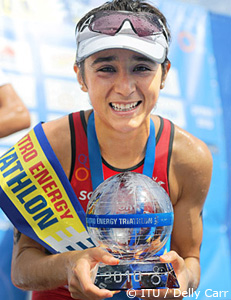
ST: Did the diagnosis involve finding out what her training emphasis was last year?
Darren: Yeah. I had considerable insight into her training program because I know Jamie Turner well and he was happy to share his approach with me when I began working with Barb. He is an excellent coach and I know the issues he was focusing on at that stage of her development. I think it is fair to say they worked very hard on the swim and at various other times overloaded the bike and run. Maybe it was too much overload for someone not used to doing so much. If a coach overloads for a period, the body needs to be in a certain state of health to handle the workload. If not, then it won’t work.
ST: When she made her break on the last lap of the run, it looked as if she did it with shorter strides and a very high cadence. Was that technique something you taught her to do?
Darren: Actually, when she started with us, her range of motion was very small at the hip because of her injuries. Consequently her stride was too small and her turnover was too high. Once we straightened out her injuries with therapy and worked on her technique, she used more stride length and required less cadence than before. So the first laps of the run in Sydney were at a controlled pace and the video shows an improvement in stride length compared to last year. But at the business end of the last lap, the pace was faster and was not as economic and didn’t look as pretty. She reverted a little to get the job done. But all in all we have actually improved things and stopped her from having such a high cadence.
ST: What other things did you change to get her bike stronger and able to stay near the front pack after a 40th place swim?
Darren: That place doesn’t matter if you are in the front pack by the end of the bike. It’s fair to say we also strengthened her bike considerably and her run. The approach from last year with the previous coach was more heavily weighted to cure the swim and neglected her strengths. It may well have been the right thing to do at the time. But now, I tried to re-establish her weapons, her strengths in the bike and run, and to take a slightly different journey with her weakness.
ST: During the middle laps, it seemed as if all four members of the group made surges. Did it hurt to stay with them?
Barbara: Yes it hurt. But that is pretty standard, to have different rhythms through the race.
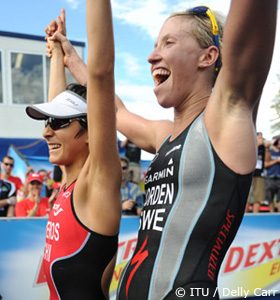
ST: As you came to the final lap, did you have an idea where you might make a move?
Barbara: I thought they could use their strength on the flat and it would be really hard to get past them there. On the hill, they are bigger and taller and maybe they have more resistance. So I thought I would try to make a break up the hill [on Macquairie Street]. That didn’t work, so I pushed myself really hard coming back on the downhill and just relaxed and kept calm and let myself go. Yes, I might have taken shorter strides and faster turnover.
ST: When did you see your surge had worked?
Barbara: At the last corner coming to the finish, I saw I had a few meters. I thought if I could hold it I could win. I push myself the last 20 meters and when I hit the tape, I raised my arm in the air.
ST: What did you feel at that moment?
Barbara: I am thinking I can’t believe what I did. Maybe I will realize it in the future, but not now.
Darren: When Barbara won she was in a state of shock and stood by herself until Lisa Norden came by and grabbed her and hugged her and stood behind her and held her hands up for the crowd. That was great on both fronts. It showed great empathy and depth of feeling from Nordo, after she had lost, to do that for a teammate. Lisa is a great lady on multiple levels even in defeat to still grab the hand of a teammate. That also speaks volumes how Barbara is regarded within our squad.
ST: What did this victory mean to you, Barbara?
Barbara: It means that I can do it. When I first started triathlon, I tried to make the Olympics and I did it, I made it to Beijing. And then I set a new goal, a new challenge, top finish top 10 and I made it. And at Sydney I reached a goal to win a World Cup.
ST: What did this mean for your country, which has been hit hard by a terrible earthquake?
Barbara: I guess for them it’s a big thing, it gives them a lot of pride. I heard from my old training partner back in Chile, Mario Fava. He told me ‘When you crossed the line, we were crying. We could not believe it. It honors me to see you win.’ He said it meant that all the hard work you have been doing since you were nine years old has been worth it. He said they were really happy, and this brings to your country positive energy and the belief that you can still do it if you are clear what your dreams are and your goals are.”
ST: What have you been able to do for your country after the devastating earthquake?
Barbara: Nothing practical. But after this race, I dedicate this win to them and I hope this gives them happiness and belief that they can get up and come back.
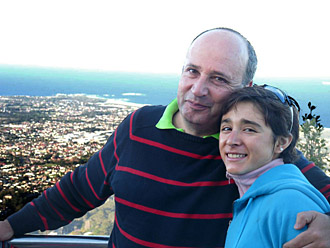
ST: Word is that in the beginning, you ran with your father when you were eight years old. He has worked hard and supported your development and serves as your manager. In one story on your family, it says “her father came to spend over half the household budget on Barbara’s career since its inception.” That amount has been at times $50,000 a year. What has his support meant to you?
Barbara: My dad Augustin Riveros is an engineer but he was always a runner. When he was training for New York marathon he took me running. He always supported me and believed I could do it. Yes, he has always had tremendous faith in me and I am always so grateful to have him behind me. In our country, he is always the person who gets the money for me to train and race. Even when the money is not right there, he just does it and says ‘I will figure later how to get it.’ And from him I learn to have faith in myself as well.
Darren: Her father has given her constant support even though they have a large family and come from a relatively poor country. He’s been able to manage things very well and has helped to form an extremely well organized national federation and is instrumental in gaining funding. Time and again he has gone to bat for Barbara, and to her credit she always comes back and delivered the results she is capable of. So he's been a rock.
ST: Barbara, have you met Chile’s great Ironman competitor, Cristian Bustos? He is retired now but your country truly adored him.
Barbara: Yes. We belong to the same sports club, Club Deportivo Universidad Católica, and we talk a lot. I met him and I definitely think a lot of him. When I was a young junior and did well at the Pan American champs, he said ‘OK good job. Now you will be a professional.’ For sure he is the best. He is very courageous and when he was so badly injured [in 1994 he was run over by a jeep during race in Argentina] he came back. What was most important for me is that he came back to Hawaii after the crash where he almost died. So he is incredible. For me it’s not about the win or to be first in the world. It’s about coming back and doing good after being really bad off.
ST: Among your competitors do you look up to and why?
Barbara: Lisa Norden, now that I know her. And Emma Snowsill. I have only talked to her a few times. I don’t know her well. It just seems that she is mentally tough. She doesn’t care what other people think of her. She just believes in herself.
ST: Who do you look up to outside of sport?
Barbara: Ballet dancers. We never realize that they are really tough and work so hard. Sometimes they are more committed than athletes. Not many people in sports know this because ballet dancers are not in the Olympics.
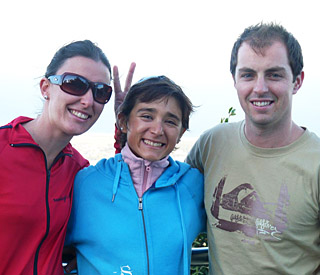
ST: I hear you were educated in Waldorf schools, which emphasize a mix of the spirit, the arts and music, respect for the environment, and healthy food.
Barbara: My education gave me a respect for the environment and natural things. Lots of times kids get really worried about the grades too early and this puts stress on them. I learned to study because I wanted to — not because someone would give me higher marks. We studied classical music and I learned to play flute and piano. I think it’s a complement for me. Life is not all about sport — you can have a lot of things happening in life. I am glad I have the connection between the mind and the soul and the spirit.
ST: Has your education helped your sport as well?
Barbara: I think you are a stronger person if you have to do a thing because you love it. For me, to feel my soul my heart is very important. I don’t want to be machine focused only on my results, because you have the rest of the people to think about. For example, when you win, your attitude is not “OK you win so you feel important.” You also feel a big debt to others who have helped you along the way. Your spirit has to grow as well.
ST: Darren, when I hear you say Barbara is a little crazy, I think you mean that in all fondness. What do you mean by that?
Darren: She is a very South American girl and they are a very passionate people. She is fiery and strong minded and she is what we call a chicka. [the Australians add an English ‘k’ to the Spanish word chica] That’s small girls, fiery girls.
ST: How does that mix with the rest of the girls in your squad?:
Darren: Very well. You know I have Sarah Groff of the US in my squad as well. She and Barbara are like big sister, little sister, and the two of them provide endless entertainment. They wear the same color swim costume, the same goggles and the same old ITU swim caps. They are both nuts – and quite lovely at that.


